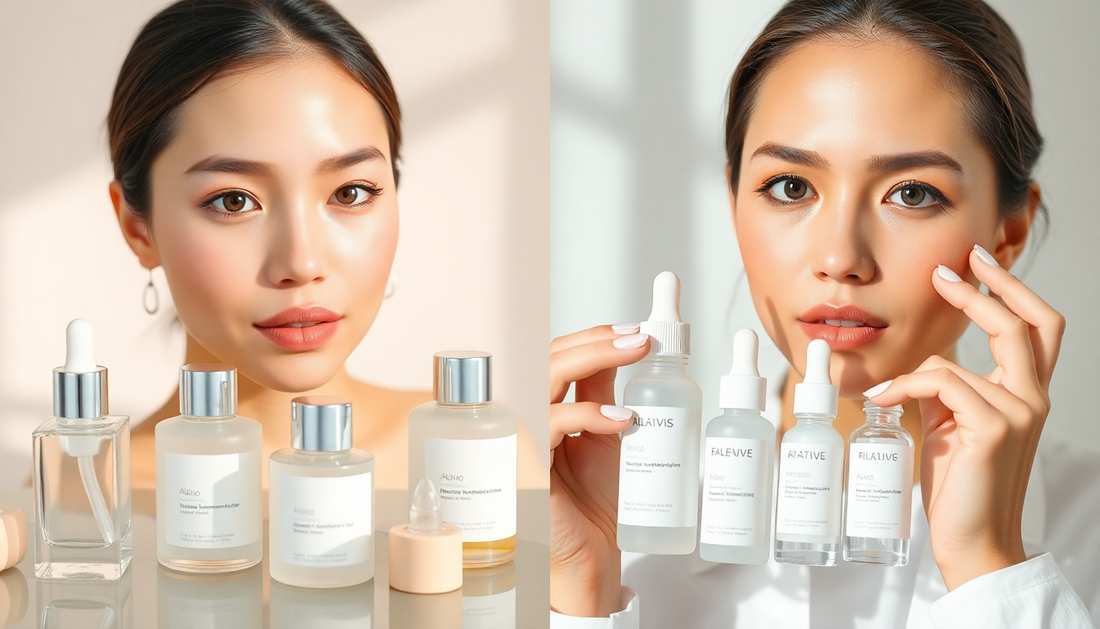
K-Beauty vs. American Skincare: What's Better for Your Skin Type?
Share
Skincare has become a true passion for many of us, with a dizzying array of products and philosophies to choose from. Two of the most prominent approaches in the beauty world are K-Beauty (Korean skincare) and American skincare. But which one is better suited to your unique skin type and needs? Let's dive in and explore the differences.
Understanding K-Beauty
K-Beauty has taken the world by storm, captivating Gen Z and millennials with its innovative, multi-step routines and focus on natural, gentle ingredients. At the heart of K-Beauty is the belief that healthy, glowing skin starts with a meticulously curated regimen.
Key characteristics of K-Beauty include:
- Emphasis on hydration and nourishment
- Use of fermented, botanical, and probiotic-rich ingredients
- Multi-step routines (cleansing, toning, essence, serum, moisturizing, etc.)
- Gentle, non-irritating formulas
- Innovative textures like essences, ampoules, and sheet masks
K-Beauty brands often prioritize ingredients like snail mucin, propolis, and centella asiatica, which are prized for their soothing, hydrating, and skin-repairing properties. The overall philosophy is to treat the skin with the utmost care and patience, gradually building a healthy, radiant complexion.
Understanding American Skincare
In contrast, American skincare tends to take a more direct, results-oriented approach. While K-Beauty emphasizes the journey, American brands often focus on targeted solutions for specific skin concerns.
Some key characteristics of American skincare include:
- Emphasis on active ingredients and clinical efficacy
- Use of retinoids, alpha-hydroxy acids, and other potent compounds
- Streamlined, efficient routines
- Formulas designed to address specific issues (acne, wrinkles, hyperpigmentation, etc.)
- Packaging and marketing that highlights scientific credibility
American skincare brands often draw inspiration from dermatological research, incorporating powerful ingredients like vitamin C, benzoyl peroxide, and salicylic acid to tackle common skin problems head-on. The goal is to achieve visible, measurable results in a shorter timeframe.
Comparing Skincare Approaches
When it comes to methodology, K-Beauty and American skincare take quite different approaches. K-Beauty emphasizes a holistic, long-term view, while American skincare is more focused on targeted, immediate results.
In terms of product formulations, K-Beauty tends to favor gentler, more nourishing ingredients, while American brands often incorporate higher concentrations of active compounds. K-Beauty products are typically designed to be layered and used in a specific order, while American skincare is often more streamlined and can be used more flexibly.
Both approaches have their merits, and the "better" option ultimately depends on your individual skin type and concerns.
Matching Skincare to Skin Types
Oily Skin: K-Beauty's focus on hydration and soothing ingredients can be a game-changer for oily skin types, helping to balance sebum production and minimize breakouts. American skincare's use of mattifying, oil-controlling actives like salicylic acid and benzoyl peroxide can also be highly effective.
Dry Skin: K-Beauty's emphasis on nourishment and barrier repair makes it an excellent choice for dry, dehydrated skin. The layered, hydrating approach can help replenish moisture and plump up the complexion. American skincare's retinoids and alpha-hydroxy acids may be too harsh for dry skin, potentially exacerbating dryness and irritation.
Combination Skin: Navigating combination skin can be a delicate balance. K-Beauty's customizable, multi-step routines allow you to target different zones with the appropriate products. American skincare's versatile, targeted solutions can also be a good fit, as long as you're mindful of not over-drying certain areas.
Sensitive Skin: K-Beauty's gentle, soothing formulas are often a safer bet for sensitive skin types. The focus on calming, anti-inflammatory ingredients can help minimize irritation and redness. American skincare's potent actives may be too harsh, potentially causing further sensitivity.
Pros and Cons
K-Beauty Advantages:
- Holistic, long-term approach to skin health
- Emphasis on hydration and nourishment
- Gentle, non-irritating formulas
- Innovative, customizable routines
American Skincare Advantages:
- Targeted solutions for specific skin concerns
- Clinically-proven, high-performance ingredients
- Efficient, streamlined routines
- Visible, measurable results in a shorter timeframe
Potential Drawbacks:
- K-Beauty routines can be time-consuming
- American skincare may be too harsh for sensitive skin
- Both approaches may not work for every individual skin type
Expert Tips for Choosing the Right Skincare
Identifying your skin type is the first crucial step in selecting the right skincare approach. Consult with a dermatologist or esthetician if you're unsure, as they can provide personalized guidance.
Don't be afraid to mix and match elements from both K-Beauty and American skincare. For example, you could incorporate a K-Beauty essence or sheet mask into an otherwise American-style routine. The key is finding the right balance for your unique skin needs.
Remember that skincare is not a one-size-fits-all solution. Be patient, experiment, and listen to what your skin is telling you. With the right regimen, you can achieve the healthy, radiant complexion of your dreams, whether it's through the lens of K-Beauty or American skincare.
Conclusion
In the battle of K-Beauty vs. American skincare, there is no clear winner – the "better" option ultimately comes down to your individual skin type and concerns. By understanding the key differences between these two approaches, you can make an informed decision and curate a skincare routine that truly works for you. Embrace the journey, and let your skin be your guide.
